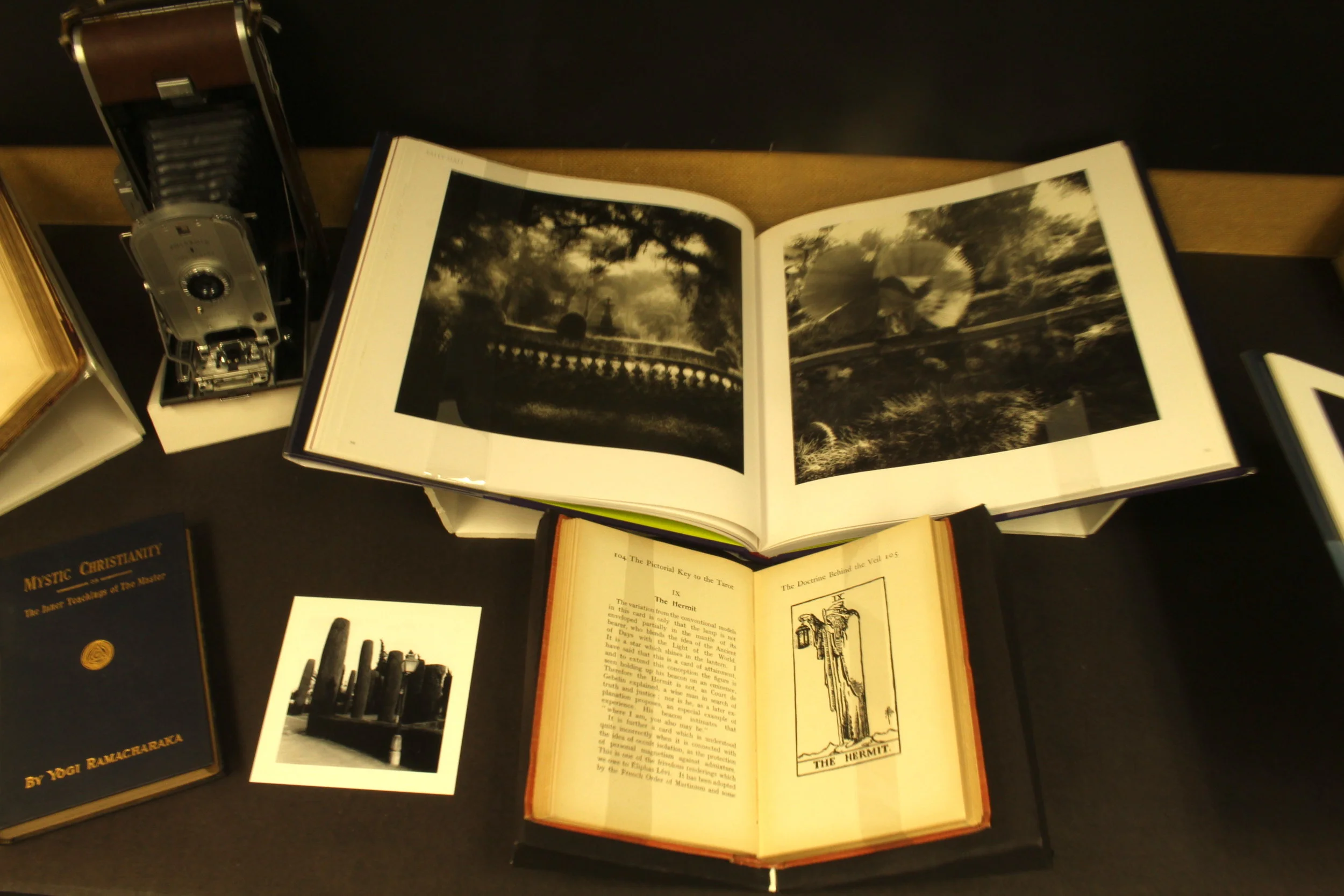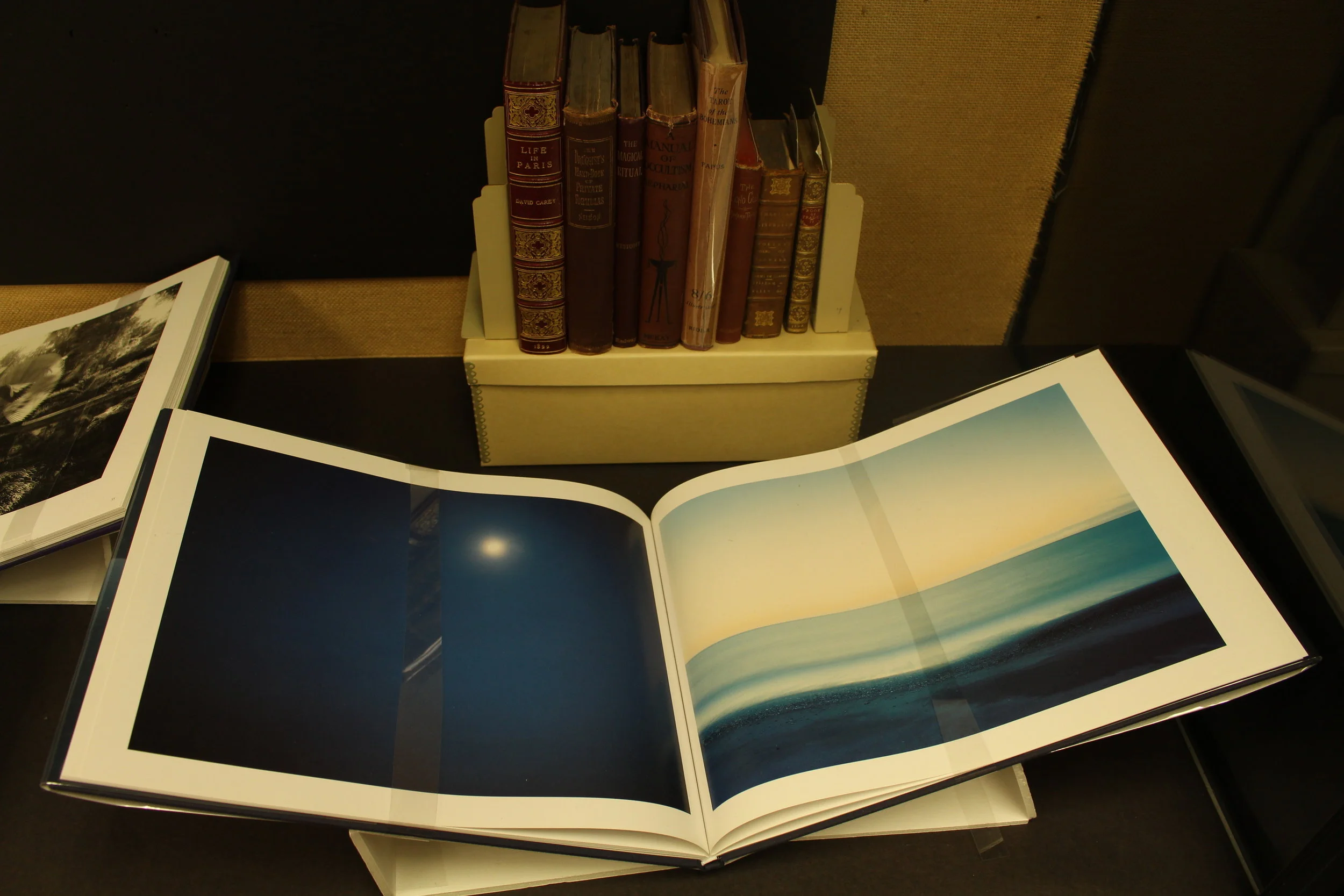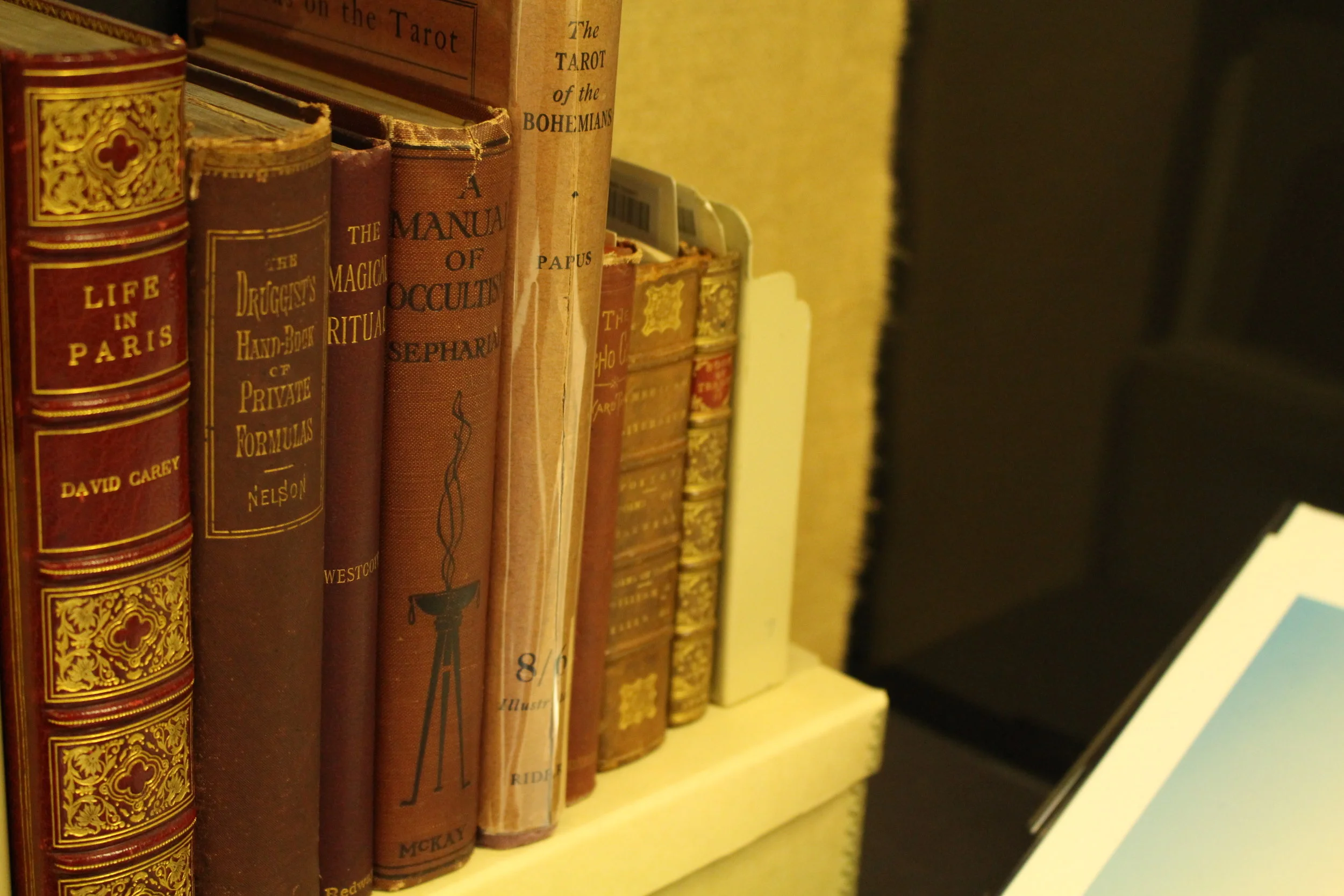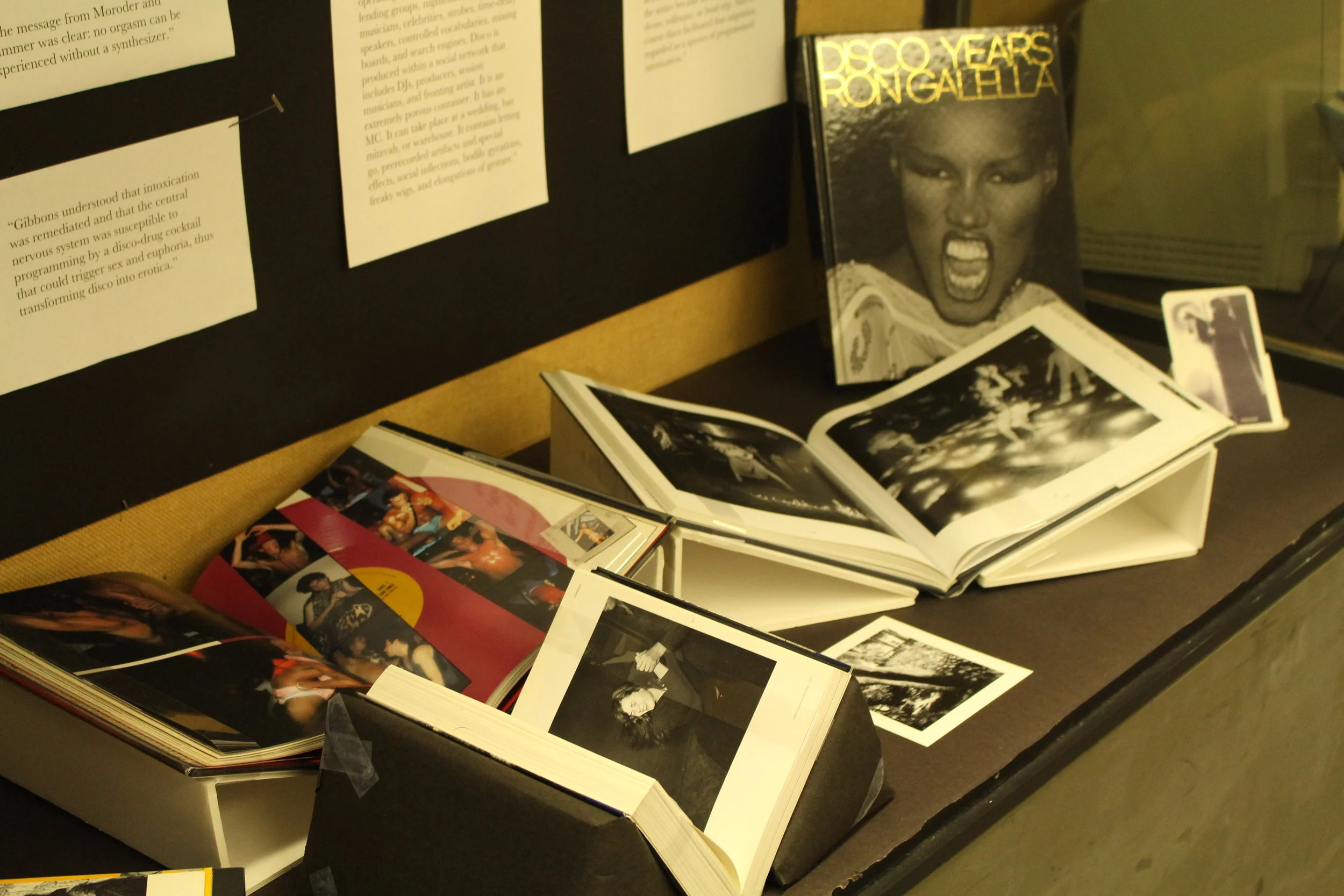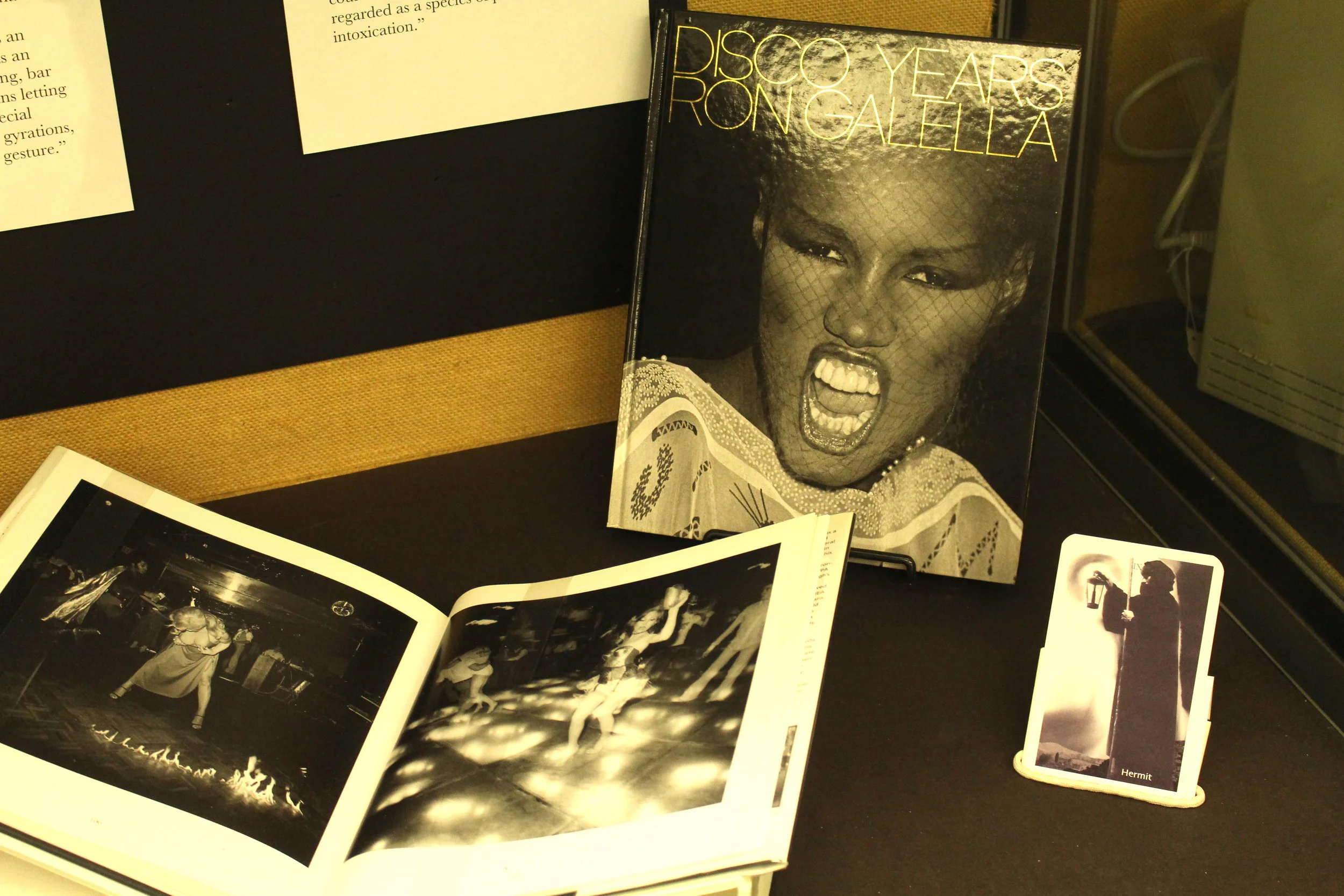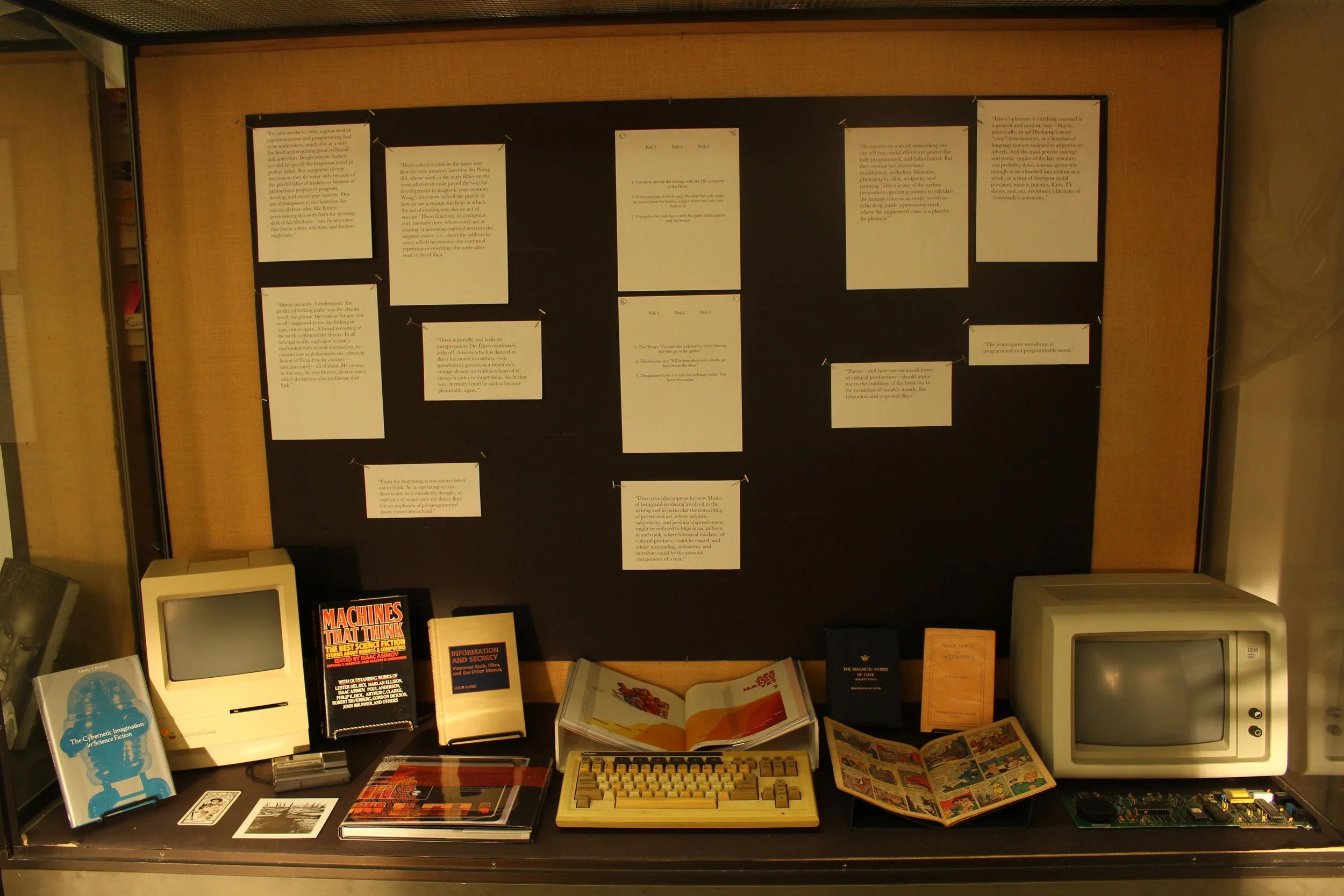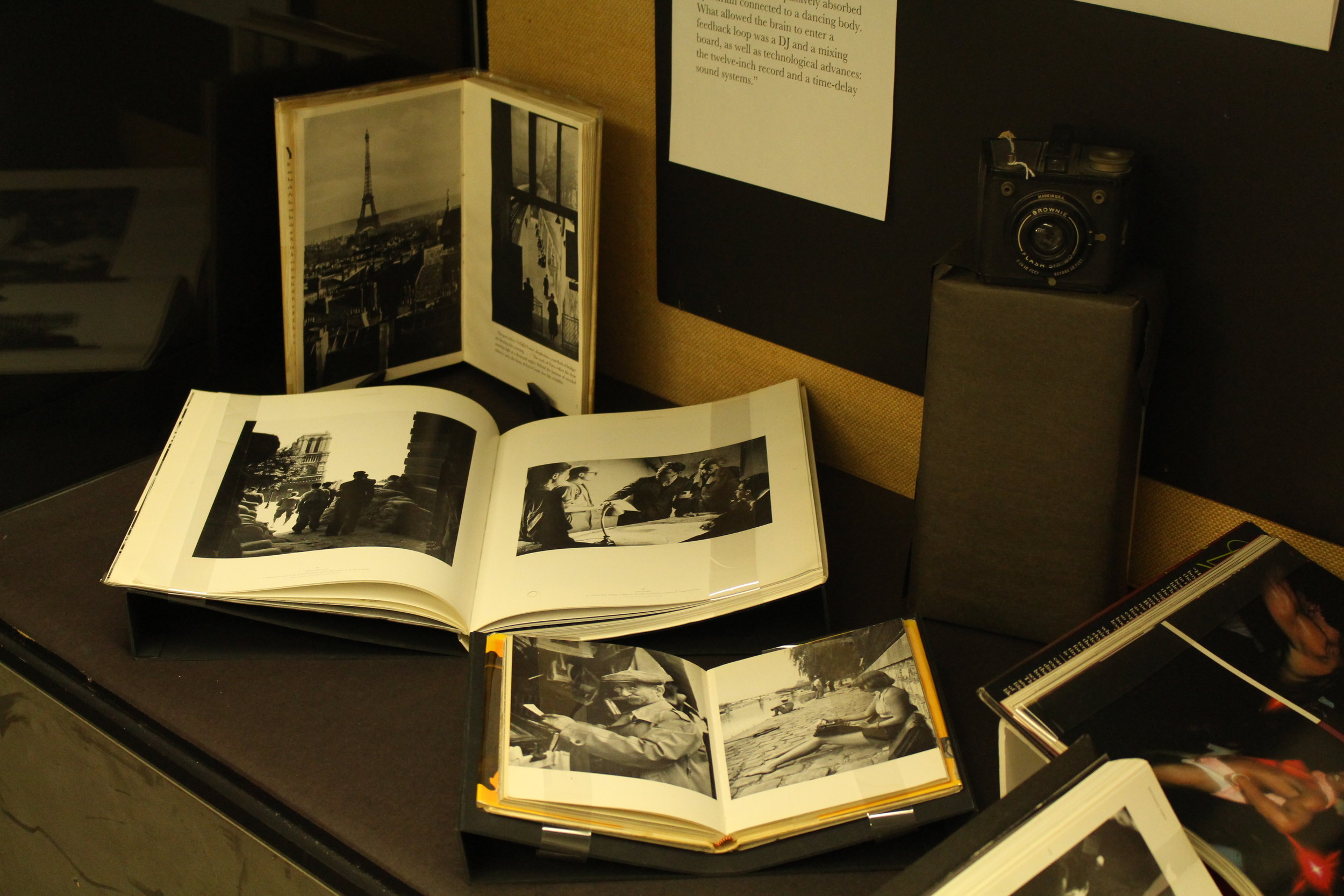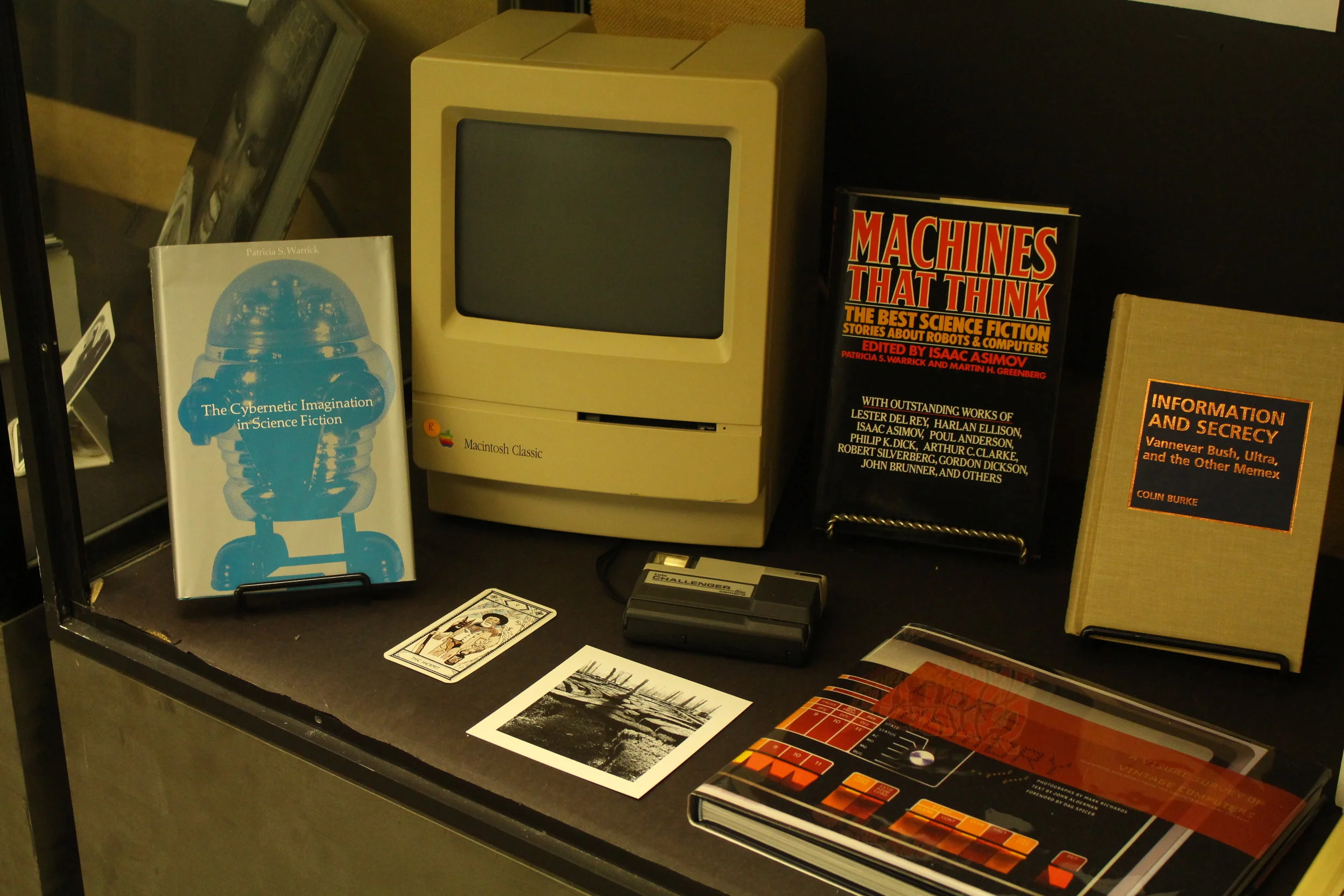Hermit at the Disco
Hermit at the Disco, 2016, is a curated three-case archive installation that represents connections between Jorge Luis Borges’ The Garden of Forking Paths (1941) and Tan Lin’s Disco as Operating System, Part One (2008). The first case represents “The Hermit’s Library,” the second “The History of Disco,” and the third “The Technological History of Social Media.” The piece includes quotes from the two publications, along with hypertext written by the artist. The viewer moves between the three cases, making story choices that result in a separate ending each time.
The Garden of the Forking Paths takes place during World War II. After Hitler and the Nazi party came to power, live music performance was prohibited in occupied Paris. As if Parisians would ever stop partying, they started playing vinyl instead of performing live. People socialized with records as a form of resistance, and that is how the first discothèque started. Disco as Operating System explores how disco evolved in America and its existence as a precursor to social media.
The title of this installation reflects the similarity between the character of Albert in The Garden of the Forking Paths and the archetype of “The Hermit” in the Tarot. Both represent inward reflection that is then shared to the world.
The piece aims to showcase the hidden connections between Disco, Social Media, New Media, Mysticism, and Resistance.
Quotes
The Garden of Forking Paths
“For new media to exist, a great deal of experimentation and programming had to be undertaken, much of it at a very low level and requiring great technical skill and effort. Borges was no hacker; nor did he specify the hypertext novel in perfect detail. But computers do not function as they do today only because of the playful labor of hackers or because of planned-out projects to program, develop, and reconfigure systems. Our use of computers is also based on the visions of those who, like Borges—pronouncing this story from the growing dark of his blindness—saw those course that future artists, scientists, and hackers might take.”
“A lamp enlightened the platform but the faces of the boys were in shadow. One questioned me, ‘Are you going to Dr. Stephen Albert’s house?’ Without waiting for my Andrew, another said, ‘The house is a long way from here, but you won’t get lost if you take this road to the left and at every crossroads turn again to your left.’ I tossed them a coin (my last), descended a few stone steps and started down the solitary road. It went downhill, slowly. It was one of elemental earth; overhead the branches were tangled; the low, full moon seems to accompany me.”
“Almost instantly, I understood: ‘the garden of forking paths’ was the chaotic novel; the phrase ‘the various futures (not to all)’ suggested to me the forking in time, not in space. A broad rereading of the work confirmed the theory. In all fictional works, each time a man is confronted with several alternatives, he chooses one and eliminates the others; in fiction of Ts’ui Pen, he chooses—simultaneously—all of them. He creates, in this way, diverse futures, diverse times which themselves also proliferate and fork.”
“I thought of a labyrinth of labyrinths, one of sinuous spreading labyrinth that would encompass the past and the future and in some way involved the stars. Absorbed in these illusory images, I forgot my destiny of one pursued. I felt myself to be, for an unknown period of time, an abstract perceiver of the world. The vague, living countryside, the moon, the remains of the day worked on me, as well as the slope of the road which eliminated any possibility of weariness. The afternoon was intimate, infinite. The road descended and forked among the now confused meadows. A high-pitched, almost syllabic music approached and receded in the shifting of the wind, dimmed by leaves and distance. I thought that a man can be an enemy of other men, of the moments of other men, but not of a country: not of fireflies, words, gardens, streams of water, sunsets. Thus I arrived before a tall, rusty gate. Between the iron bars I made out a poplar grove and pavilion. I understood suddenly two things, the first trivial, the second almost unbelievable: the music came from the pavilion, and the music was Chinese. For precisely that reason I had openly accepted it without paying it any heed. I do not remember whether there was a bell or whether I knocked with my hand. The sparkling of the music continued.
From the rear of the house within a lantern approached: a lantern that the trees sometimes striped and sometimes eclipsed, a paper lantern that had the form of a drum and the color of the moon. A tall man bore it. I didn’t see his face for the light blinded me. He opened the door and said slowly, in my own language: ‘I see that the pious His Peng persists in correcting my solitude. You no doubt wish to see the garden?’
I recognized the name of one of our consuls and I replied disconcerted, ‘The garden?’
“The garden of forking paths.”
“The Garden of Forking Paths is an enormous riddle, or parable, whose theme is time; this recondite cause prohibits its mention. To omit a word always, to resort to inept metaphors and obvious periphrases, is perhaps the most emphatic way of stressing it. That is the tortuous method preferred, in each of the meanderings of his indefatigable novel, by the oblique Ts’ui Pen. I have compared hundreds of manuscripts, I have corrected the errors that the negligence of the copyists has introduced, I have guessed the plan of this chaos, I have re-established—I believe I had established—the primordial organization, I have translated the entire work: it is clear to me that not once does he employ the word ‘time.’ The explanation is obvious: The Garden of Forking Paths is an incomplete, but not false, image of the universe as Ts’ui Pen conceived it. In contrast to Newton and Schopenhauer, your ancestor did not believe in a uniform, absolute time. He believes in an infinite series of times, a growing dizzying net of divergent, convergent and parallel times. This network of times which approached one another, forked, broke off, or were unaware of one another for centuries, embraces all possibilities of time. We do not exist in the majority of these times; in some you exist, and not I; in others I, and not you; in others, both of us. In the present one, which a favorable fate has granted me, you have arrived at my house, in another, while crossing the garden, you found me dead in still another, I utter these same words, but I am a mistake, a ghost.”
Disco as Operating System
“At any rate, disco’s influence as a post-medium format transcended dance culture at the Loft, the Paradise Garage, or Studio 54. By the early years of the century, the disco sound had morphed into not only house music but into production and distribution practices associated with ‘social media.’
With its divergent music-making techniques (beat-matching, slip-cuing), social venues (dance clubs), low-cost or free distribution models (record-lending pools, nominal club admission), social practices, and changing technologies (mixing board, twelve-inch single, amyl nitrate), disco is not principally a commodity pressed on vinyl and consumed in a rec room, but a cultural format accessed in a communal setting where the line between singing and acting, listening and participating, between a celebrity and what Warhol called a ‘nobody,’ and between an individual and a network were being dissolved in an era marked by flexible accumulation and the transformation of culture into a fluid species of capital.
It was also a technologically specific medium whose production and mode of accessing can be linked to the development of magnetic core memory systems. But you didn’t have to be an economist or a computer expert to note how changes in the market affected stardom in a network where human actions resembled machine based protocols enabling data to copy itself.
As an ambient environment or operating system in which varied practices transpire, disco is the (sound of) data entering (input) and leaving (output) a system, where multiple sources are accessed in a time that simulated to feel like a real-time operation.” P82-83
“Disco’s pleasure is anything accessed in a general and random way—that is, generically, or ad Duchamp’s word “even” demonstrates, as a function of language not yet assigned to adjective or adverb. And the most generic concept and poetic engine of the late seventies was probably disco, a music genre-less enough to be absorbed into culture as a whole, in a host of divergent social practices, musics, poetries, films, TV shows, and, yes, everybody’s lifestyles of “everybody’s autonomy.” P86
“Suddenly disco was everywhere, a product without clear origins, broadcast indiscriminately like Tennyson’s and Longfellow’s trance-inducing poems in the nineteenth century or home décor in the post-Bauhaus era.” P87
“In a sense, for punk musicians the mainstream culture alike, disco could hardly be thought about. Yet its distastefulness suggests a way of visualizing avant-garde practices dissolving into something generic, something for which the idea of medium, race, and sexual orientation was rendered mostly irrelevant as disco became mainstreamed. Disco is the site where the social protests explicitly linked to street actions and avant-garde happenings of the sixties became an interiorized lullaby, drone, soliloquy, or head trip. And of course disco facilitated that migration, regarded as a species of programmed intoxication.” P87
“From the beginning, it was always better not to think. As an operating system, disco is not, as is mistakenly thought, an explosion of sound onto the dance floor but an implosion of pre-programmed dance moves into a head.” P88
“In place of listening, the brain is a passive regulator in a feedback loop. The dance floor is a series of mathematically induced aural hallucinations that involved the production and redistribution of music or, to be more accurate, musical effects. Everything else gets methodically filtered or subtracted out. No one really listens to disco, not even the listener; it is passively absorbed by a brain connected to a dancing body. What allowed the brain to enter a feedback loop was a DJ and a mixing board, as well as technological advances: the twelve-inch record and a time-delay sound systems.” P88
“Disco as a medium or a genre—of what? Music? Lifestyle? Home décor? Production techniques?—was a pretty unthinkable except as an integrated layer of medial practices: poetry, painting, operating systems, software, record lending groups, nightclubs, session musicians, celebrities, strobes, time-delay speakers, controlled vocabularies, mixing boards, and search engines. Disco is produced within a social network that includes DJs, producers, session musicians, and fronting artist. It is an extremely porous container. It has an MC. It can take place at a wedding, bar mitzvah, or warehouse. It contains letting go, prerecorded artifacts and special effects, social inflections, bodily gyrations, freaky wigs, and elongations of gesture.” P88-89
“Gibbons understood that intoxication was remediated and that the central nervous system was susceptible to programming by a disco-drug cocktail that could trigger sex and euphoria, thus transforming disco into erotica.” P89
“The message from Moroder and Summer was clear: no orgasm can be experienced without a synthesizer.” P90
“As anyone on a social networking site can tell you, social effects are groove like, fully programmed, and hallucinated. But then erotica has always been multiformat, including “literature, photography, film, sculpture, and painting.” Disco is one of the earliest premodern operating systems to calculate the human voice as an erotic reverb or echo deep inside a percussion track, where the engineered voice is a placebo for pleasure.” P91
“Disco solved a crisis in the same way that the core memory inventor An Wang did, whose work in the early fifties on the write-after-read cycle paved the way for developments in magnetic core memory. Wang’s invention ‘solved the puzzle of how to use a storage medium in which the act of reading was also an act of erasure.’ Disco functions as a magnetic core memory does, where every act of reading or accessing material destroys the original source (i.e., clears the address to zero), which necessitates the continual repetition or rewriting (the write-after-read cycle) of data.” P93-94
“Disco is parodic and lacks an interpretation. Or: Disco continually jerks off. Anyone who has danced to disco has noted its curious, even paradoxical, powers as a mnemonic storage device: an endless rehearsal of things in order to forget them. An in that way, memory could be said to become pleasurable again.”P94
“The avant-garde was always a programmed and programmable mood.” P95
“Disco provides impetus for new Modes of being and nonbeing involved in the writing and in particular the nonwriting of poetry and art, where lyricism, subjectivity, and personal expressiveness might be reduced to blips in an ambient sound track, where historical markers (of cultural products) could be erased, and where nonreading, relaxation, and boredom could be the essential components of a text. Poetry—and here one means all forms of cultural productions—should aspire not to the condition of the book but to the condition of variable moods, like relaxation and yoga and disco.” P96-97



